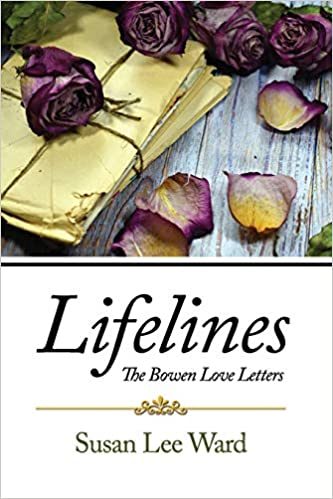Katie Bowen’s Larder
A larder is a cool area for storing food prior to use. Originally, it was where raw meat was larded—covered in fat—to be preserved. By the eighteenth century, the term had expanded. Now a dry larder was where items like bread, pastry, preserves, herbs and spices, milk, butter, and cooked meats were stored. Larders were commonplace in houses before the widespread use of ice boxes.
Keeping a good larder was an essential responsibility of women, along with other household chores. A lady’s larder was kept in a cool, dry and well-ventilated area if possible, usually on the shady side of the house. It might have a door to an outside yard and windows with wire gauze to keep out flies and other pests.
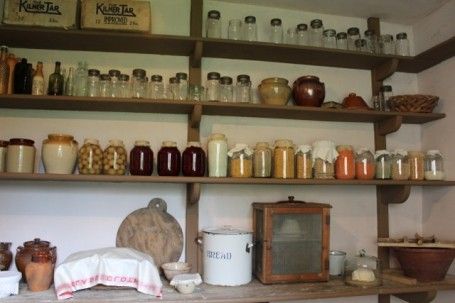
Magazine Larder for Butter and Cream
In Lifelines – The Bowen Love Letters, Catherine “Katie” Cary Bowen lived with her parents in Houlton, Maine, where they were able to keep food cold with ice harvested from nearby rivers. When Katie was first able to set up her own household as a married woman, she and her husband, First Lieutenant Isaac Bowen, lived at Fort Mifflin, near Philadelphia, and kept their butter in the fort’s gunpowder magazine, an area inside the fort designed to store the explosive gunpowder in wooden barrels for safely. It met the requirements for a cool, dry and well-ventilated area.
For the past week I have been putting down our little churnings, as we were making more butter than we use. You will laugh when I tell you where I keep our butter – in the magazine, to be sure. The building stands by our kitchen door and as the first entrance has nothing to do with the powder department, my good man gave permission to set the butter tub and cream jug in this place. The building is of brick with the walls immensely thick. On the inside of the first wall is a passage all around, with the magazine district room in the center. In one corner of this cold passage we keep our butter, getting it out once a day for use. We make about six pounds a week and have as much new milk and cream as we want.
Katie Bowen to her mother from Fort Mifflin, Philadelphia
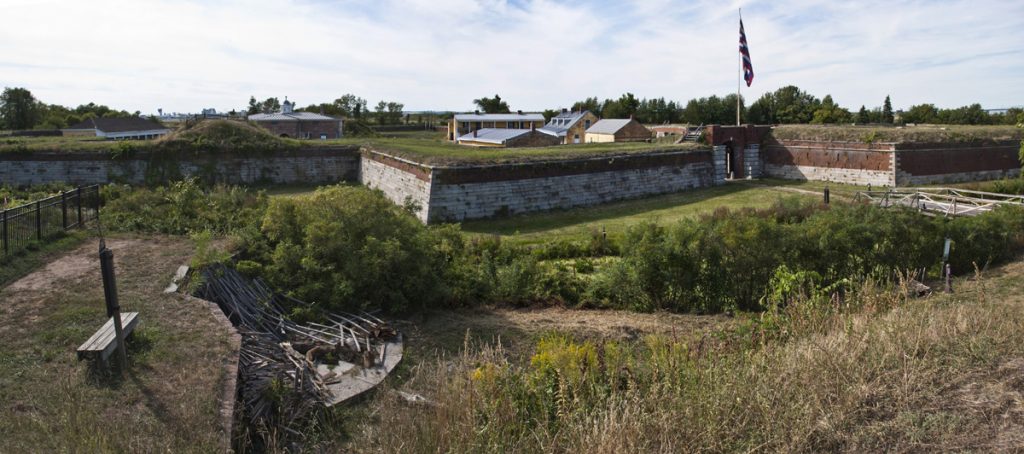
Katie was delighted to finally set up her first household and was determined to try everything in the kitchen. She was particularly proud of making butter, and this pride lasted for many years – at Fort Mifflin and Schuylkill Arsenal, on the Santa Fe Trail, and while living in the New Mexico Territory, first at Fort Union, and then in the small towns of Albuquerque and Santa Fe.
Katie’s Larder Stock
Butter and eggs are quite dear, but we shall save all the crumbs, and try not to break the bank. We have a stock laid by that will last quite a while – a firkin of butter, hams, apples, mackerel, flour, and dozens of other things. I take a great deal of pride in knowing how to do and having things done in good order, and as soon as I learn the way that is right, we will have as nice a house as anybody. At present we get milk from Mrs. McIntosh and right nice, rich milk it is, and we have a good quart in the morning and set it for cream for our coffee next morning, and by managing in that way, we have milk for puddings or mixing cakes, or any other purpose beside giving Isaac his tumbler full at night.
Katie to her mother on December 17, 1848, Fort Mifflin, Philadelphia
Katie and Isaac used butter in the same way we now use plant-based oils for cooking, baking, and slathering on bread. She most likely used a barrel-type butter churn at Fort Mifflin. They were not alone in their love of and reliance on butter.
Evidence for the use of butter dates back as early as 2000 BC, and there is mention of it in biblical works. The butter churn itself may have existed as early as the 6th century AD, as can be seen by what appears to be a churn lid dating from that era. In the European tradition, the butter churn was primarily a device used by women, and the churning of butter was an essential responsibility. In earlier traditions of butter making, nomadic cultures placed milk in skin bags and produced butter either by shaking the bag manually, or possibly by attaching the bag to a pack animal, and produced butter simply through the movement of the animal. Some theorists believe this is how the butter creation process was discovered.
I have been working over our butter this morning which was churned Saturday, and had the large prints. I think we make nearly or quite 6 pounds a week – at any rate, more than we consume at present.
Katie to her mother on May 7, 1849, Fort Mifflin, Philadelphia
By the end of 1850, Isaac Bowen had a new position that came with a promotion to Captain, Chief of Commissary for the New Mexico Territory. It was a position created by Congress:
On the 30th of May, 1848, Brevet Brigadier General George Gibson, commissary-general of subsistence, was appointed a major-general, by brevet, “for meritorious conduct, particularly in performing his duties in prosecuting the war with Mexico.”
On the 4th of January, 1850, General Gibson addressed a letter to the Secretary of War, Honorable G. W. Crawford, requesting “that there be added to the Subsistence Department four commissaries of subsistence with the rank of captain, to be taken from the line of the Army.”
In explanation of the necessity for this increase, General Gibson said:
“The addition of Oregon, California, New Mexico and Texas to our territory compels me to ask for an increase in the number of officers in the Subsistence Department. Each of these commands requires the presence of an officer of the Commissariat, and from no point occupied by my officers can one be spared for these duties.”
In the spring of 1851, Katie and Isaac Bowen took leave to visit their families and then headed to St. Louis, Missouri, on their way to Fort Leavenworth, Kansas, staging point for wagon trains headed west. Butter-making was on Katie’s mind, as well as setting by a store of food for their upcoming journey on the Santa Fe Trail.
Taking the Trouble to Make It
We wait at Fort Leavenworth for Colonel Sumner, who goes out in command of the six hundred men who accompany the train. Yesterday Isaac saw an order to send out 100 cows for government use in Santa Fe, so you see we will be able to have butter by taking the trouble to make it.
Katie to her mother on April 9, 1851, St. Louis, Missouri
There is a nice little town in Missouri called Weston, six miles above here on the opposite of the river. Tomorrow I am going with Major James Carleton and his wife, Sophia, to get some butter for our march. I am going to melt it and put it into a stone jar, more for experiment than anything else. I have discovered how to keep eggs fresh for years. Hold them in boiling water an instant, just long enough to fasten the white to the shell, and by so doing it keeps the air from penetrating through. Consequently, it preserves the meat sweet for any length of time. Sea captains do this and always have fresh eggs in any climate.
Katie Bowen to her father on April 20, 1851, Fort Leavenworth, Kansas
This river water is very sweet and healthy, only it is dreadfully muddy and needs a great deal of care to filter it. There are springs of pure water, but not very healthy, and so they are not used at all. I have commenced today to melt down my butter, and of all the froth and curds, neither I nor anyone else ever saw. The butter was as sweet and pure as olive oil after skimming and pouring gently the oil from the curds. I know it will keep and always mean to put down my butter in this way. If I had known this way at Fort Mifflin, I could have saved a winter’s supply. We will probably have three or four cows in Santa Fe and I shall experiment. You try the experiment with the eggs, for Susan Cary said she kept them for a year and does not know but they would have kept for any length of time, had she enough to try with.
Katie Bowen to her mother on April 28, 1851, Fort Leavenworth, Kansas
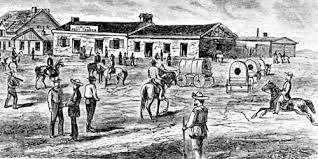
Keeping Butter Sweet for All Eternity
Colonel Woolley, the Indian agent, sent me a present yesterday of a couple of gallon bottles of mixed pickles and a quantity of the best black tea, thinking perhaps that they would be more acceptable than anything else on the plains. Although we are bountifully supplied with such things, I was very grateful to be remembered. The same gentleman sent me a very large, handsome edition of the Testament and the Psalms included, and Isaac a large volume on Farming in all its branches. I read in it that if butter was packed in a firkin with the staves charred inside and a layer of charcoal on the top after the butter was well salted and packed, that it would keep sweet till all eternity.
Katie Bowen to her mother on June 14, 1851, Fort Leavenworth, Kansas
Butter in a Tin Cup
We send to Las Vegas, 25 miles distant, for ice and vegetables and expect a couple dozen hens and chickens tomorrow, so to make our own eggs. I had a pint of cream yesterday and stirred up nearly a pound of butter in a tin cup just to say that I had made butter before Mrs. Sibley, who has been fixed a month and lived without butter, even with the milk of two cows. I have but one at present, though will have more as soon as I want them. I have 30 pounds of melted butter that I put down at Leavenworth, and it is as sweet as new cream, but you know I am always trying experiments and I want to have new butter. A man brought some for sale yesterday at 75 cents a pound.
Katie Bowen to her mother on August 24, 1851, Fort Union, New Mexico Territory
Katie’s Paddle and Earthen Pan
Time jogs along not quite fast enough for I am getting impatient for another mail. I have commenced putting down butter – in small quantities to be sure – but I can make enough at once to last us a week and then the second churning of every week I pack. We have a nice cool tent for milk and the butter always comes hard. I have a nice paddle and earthen pan for working butter and Mrs. Sibley has a fine stone churn, so we exchange favors day about. I churn Tuesdays and Fridays, and she does the same Wednesdays and Saturdays, and in that way never interfere, but get on harmoniously.
Katie Bowen to her mother on September 14, 1851, Fort Union, New Mexico Territory
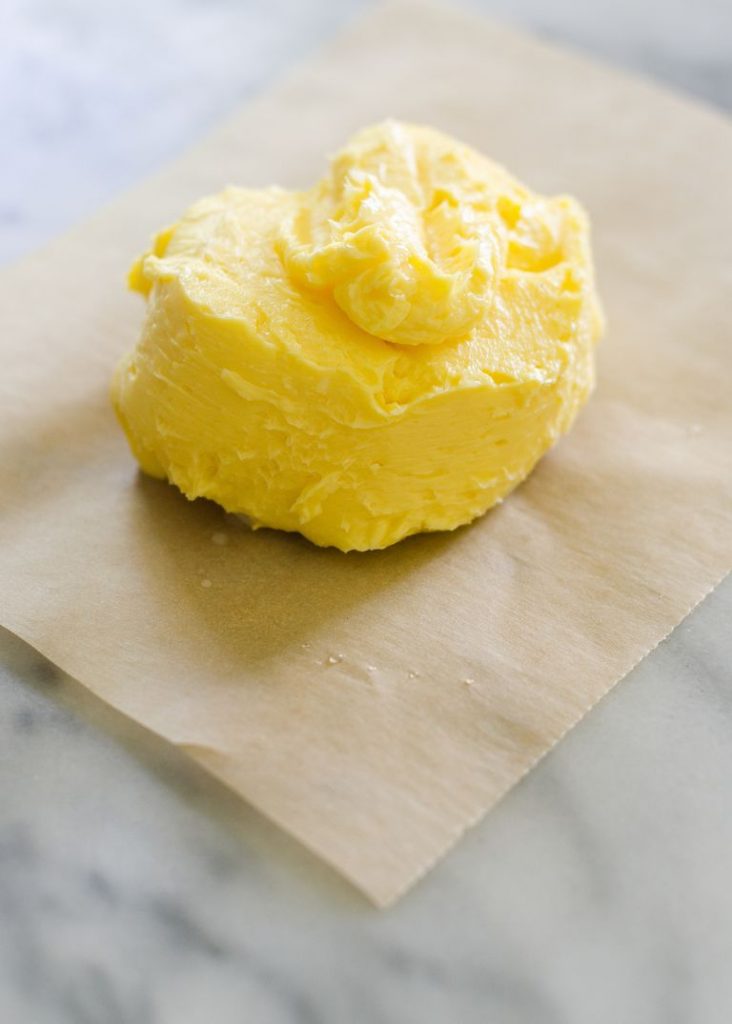
Breakfast Cake with Butter
The Mexicans bring in venison, wild fowls and onions and we manage to set a very comfortable table. A gentleman who has supplied Isaac with corn for his department said he would send us a basket of fine potatoes, but we have only been able to eat them in imagination. They sell for $12 a fanega or $5 a bushel. We have had cabbage until within a week, but at present are restricted to onions, rice and macaroni. I still make more butter than we use and had some very comfortable doughnuts and pies since cold weather set in. A mule power corn mill furnishes us with nice corn meal, and in lieu of buckwheat cakes, I will send you the recipe for breakfast cake:
One pint sifted meal
One pint sour or buttermilk sweetened with saleratus
Two spoonful’s melted butter
Two eggs
If you do not find this nice, if well baked in an oven or hot skillet, then it must be owning to the climate. I pour the mixture into a skillet and put a bake oven cover on, cover it with hot coals, and it always comes out like a loaf of sponge cake.
Katie Bowen to her parents on November 30, 1851, Fort Union, New Mexico Territory
Old Butter and New Butter
Isaac is very busy attending our numerous families in the back yard. We have forty-seven chickens, three little porkers, and a calf besides the larger stock, and never were living more comfortably. Plenty of butter and eggs and all substantials. We are the only ones in garrison who had butter all winter and the only reason is that Isaac takes care of everything himself, instead of trusting servants.
Katie to her father on May 1, 1852, Fort Union, New Mexico Territory
I am now using the butter that I made last fall and putting down fresh, about 7 pounds a week. When I work my butter to put down, I use with the salt a very little of pounded loaf sugar. Whatever was the cause I don’t know, but no one can tell my old butter from the new. As soon as I commence packing, I paste thick brown paper all over the outside of my jars to keep the air out and very likely it was a good idea, for our weather has been warm enough to spoil anything.
Katie to her mother on May 28, 1852, Fort Union, New Mexico Territory
A gentleman from Tecolote sent out a few potatoes and I have enjoyed my breakfasts more than any other meal – boiled eggs and baked potatoes are not hard to take. The chickens are fine and I have had them served up in all ways. A gentleman at Taos, Mr. Ceran St. Vrain, whose name has figured in all the reports of this country, sent us 150 onions as big as saucers and 25 heads of the crispest, whitest, largest cabbages you ever saw. So you see, we find friends in every place and these favors are very acceptable. We had 15 pumpkins from the public garden and dried them all for winter. Thus far we have had plenty of beets and turnips and tell Father we have a beef shank soup every day, and I always think of him when it when comes on the table. There are many worse places than New Mexico. Now I am going to pack butter for winter. I know if you could see our arrangements, you would say they were fine.
Katie Bowen to her parents on November 1, 1852, Fort Union, New Mexico Territory
Katie Bowen, A Good Dairy Woman
Our own cow will have a calf in a few days and I shall be independent again. From this sick cow I have made four pounds of butter a week since the grass came and flatter myself that I shall make a good dairy woman by the time Isaac settles on his land.
Katie Bowen to her mother on May 29, 1853, Fort Union, New Mexico Territory
Isaac Bowen’s Pretty Nice Mess Kit
I find time to sew a good deal and hope that we will not look quite like heathens when we reach you. Tonight Margaret is baking mince pie for the Captain’s journey. I mixed the meat this afternoon and flatter myself that it is pretty nice. Shall boil him a ham, roast a pair of fowls, and boil a junk of corned beef, which with bread, butter, pies, doughnuts, tea, coffee, &c., will last him to El Paso, and there he can coax some of the good ladies of the post to refill his mess kit.
Katie Bowen to her mother on February 28, 1855, Santa Fe, New Mexico Territory
What is Butter?
Butter is as old as Western civilization. In ancient Rome, it was medicinal–swallowed for coughs or spread on aching joints. In India, Hindus have been offering Lord Krishna tins full of ghee —luscious, clarified butter —for at least 3,000 years. And in the Bible, butter is a food for celebration, first mentioned when Abraham and Sarah offer three visiting angels a feast of meat, milk and the creamy yellow spread.
Most of us use some type of butter or butter substitute purchased from a grocery store, but what is butter? It’s a dairy product made from the fat and protein components of milk or cream. It’s a semi-solid emulsion at room temperature, consisting of approximately 80% butterfat. It can be used at room temperature as a spread, melted as a condiment, and used as an ingredient in baking, sauce-making, pan-frying, and for other cooking procedures.
Butter is made by churning milk or cream to separate the fat globules from the buttermilk. Salt, food colorings, and a variety of spices are sometimes added to butter. One of my daughters adds herbs and spices to melted butter and her family calls it “fight butter,” because they all fight over it.
Rendering butter, which is removing the water and milk solids, produces clarified butter or ghee. Butter is a water-in-oil emulsion resulting from an inversion of the cream, where the milk proteins are the emulsifiers. Butter remains a firm solid when refrigerated (or in Katie’s era, kept cool in a larder, gunpowder magazine, cool tent, or ice house), but softens to a spreadable consistency at room temperature. It generally has a pale yellow color, but that’s dependent upon the source animal’s feed and genetics.
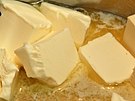
How To Make Butter
Non-homogenized milk and cream containing butterfat are surrounded by membranes made of fatty acid emulsifiers and proteins, which prevent the fat in milk from pooling together into a single mass. Butter is produced by agitating the cream, which damages the membranes and allows the milk fat to join together, separating from the other parts of the cream.
Churning produces small butter grains floating in the water-based portion of the cream. This watery liquid is called buttermilk. The buttermilk is drained off by rinsing the grains with water. Then the grains are pressed and kneaded together. On the southwestern frontier, Katie Bowen used a tin cup, paddles and an earthen pan, or borrowed her neighbor’s stone churn. Later, she probably used a barrel churn of some type. Working the grains consolidated the butter into a solid mass and broke up embedded pockets of buttermilk or water into tiny droplets.
Types of Butter Churns
The most historically prominent types of butter churns were the plunge churns – wooden containers in which the butter-making was created by moving a staff inserted into the top in a vertical motion. Another prominent type of churn was the paddle-churn, which was a container with a paddle that was operated by a handle. The barrel churn was also used extensively. It was a barrel turned onto its side with a crank attached. One particularly novel invention was the rocking chair churn, which Katie may have used when her children were babies. The device was a barrel attached to a rocking chair. When the rocking chair moved, the barrel moved and churned the milk inside into butter.

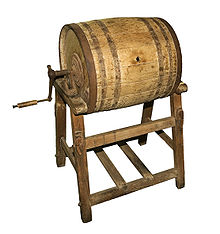
As for my era, I was born many years after refrigerators for home use were invented in the early 1900s. In the 1970s, I bought a very beautiful wooden ice box as an antique, but didn’t really understand how people kept their food cool with blocks of ice harvested from rivers and lakes. We take refrigeration for granted! And now most modern homes have panties for dry goods and refrigerators to keep food cold or frozen, and sometimes separate freezers for storage until needed. Not to mention generators in case the power goes out. It’s hard to imagine having to keep raw meat, cooked meat, fruits, vegetables, and dry goods in a larder attached to the house, in an outbuilding, or in a cellar. In Katie Bowen’s day, that’s how it was done.
For more about the adventures of Katie and Isaac Bowen, you may currently purchase Lifelines – The Bowen Love Letters at the following locations:
Dorrance Publishing Bookstore (http://bookstore.dorrancepublishing.com/)
Last Chance Store of the Santa Fe Trail Association (https://www.lastchancestore.org/)
